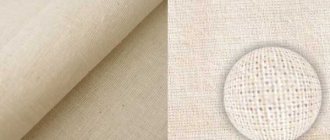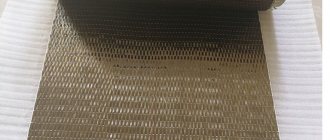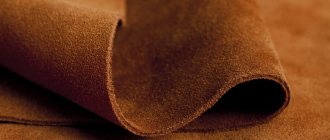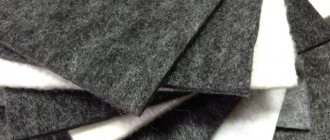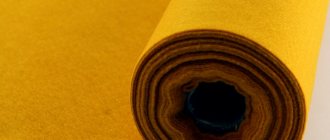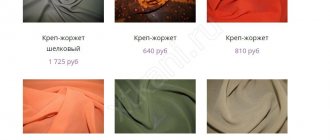What type of fabric is this, where and how is it produced?
Muslin is one of the oldest fabrics in the textile industry. Cotton, wool and silk are the basis of muslin production.
Muslin colors
It has high wear resistance, density and lightness. Very comfortable. It is based on natural fibers, but it is difficult to confuse it with other types of fabrics due to the special weaving method.
Muslin fabric - what is it?
The basis of this fabric is bleached calico - this is a very thin, almost weightless cotton fabric. However, despite its external fragility, calico is quite durable, as it contains additional thick gray fibers. At the initial stage, muslin looks unsightly, but after careful bleaching, the fabric becomes white and airy.
Today there are a large number of varieties of muslin. The raw materials for the production of this fabric can be silk, cotton, wool. Each type of material has its own application. The cotton version is more suitable for sewing linen, the silk one is more suitable for festive clothes, and the woolen one is more suitable for creating warm winter clothes.
Origin story
The birthplace of muslin is considered to be the city of Mosul (the territory of modern Iraq), known since ancient times as a center of textile production. This is where the name comes from. Since then, this delicate and “breathable” fabric has been indispensable in everyday life.
In the 15th century, the material was brought to France and Italy, and since the 15th century it has been produced in all European countries. In Russia, muslin was so popular with secular fashionistas that it is mentioned in many works of classics. And currently, muslin is one of the highest quality and most expensive fabrics.
Where is muslin fabric used?
If in the 16-17th century muslin was used only for sewing curtains and evening dresses, today the scope of its use has expanded greatly. Modern manufacturers use this fabric to create stylish and fashionable clothing, namely:
- blouses, shirts;
- summer casual dresses;
- women's and men's underwear;
- warm and light sweaters, shawls, hats;
- light trousers or shorts;
- T-shirts;
You can also buy curtains or bed linen made from muslin in large stores.
Types of fabric
Previously, muslin was produced only from 100% natural raw materials. Today they produce both natural and with the addition of synthetic threads. With the addition of synthetics, the fabric looks lighter and more voluminous, and practically does not wrinkle, which is very convenient.
Cotton muslin comes in three types:
- Tarlatan is thin, translucent, similar to muslin. Plain weaving, with a pronounced monochromatic checkered pattern
- Zephyr is a durable but very thin fabric, like a light night wind of the same name.
- Nansuk is a dense, thin fabric with a silky, smooth surface.
Wool muslin is made by twisting threads of long-staple sheep's wool. It also has characteristic transparency and volume, while retaining heat well.
Silk belongs to elite fabrics. The weaving method is the same. The fabric turns out to be weightless, thin, airy and very smooth. Twisted threads make the surface of the fabric glossy. Silk colors are pastel: pearl white, cream and soft pink. Often used for wedding dresses.
Cotton
What are the properties of cotton or cotton fabric? What are its areas of application?
more details
Silk
Fame and luxury: a detailed review of silk fabric
more details
Muslin fabric: characteristics
To fully understand what muslin fabric is, you need to understand its main characteristics and features.
- The fabric is thin and dense at the same time. This amazing combination of qualities is achieved thanks to a special type of fiber weaving. Very thin threads are taken, but the gap between them is set to a minimum.
- Muslin is a very airy and light material, and its wool variety is quite loose.
- Due to the peculiarities of weaving, the fabric is wear-resistant and has a long service life.
- The muslin production process uses twisted thread, which increases the strength of the material.
- Natural fabric has good breathability.
Products made from muslin have been very popular for several centuries for a reason. The positive qualities of this material make it irreplaceable.
Advantages and disadvantages
Pros of the fabric:
- very strong and more durable, thanks to special weaving;
- in hot weather it protects from overheating due to breathability;
- absorbs moisture well and dries quickly;
- gentle and soft, very good for babies and people with sensitive skin;
- environmentally friendly: after disposal it does not pollute the environment;
- does not roll down;
- suitable for people prone to allergies;
- Clothes made from muslin look stylish and original.
The disadvantages include:
- wrinkles a lot, like any fabric made from natural raw materials;
- high price: the absence of cheaper synthetic additives in the fabric increases the cost;
- preferable in white, since natural dyes fade strongly in the sun;
- not elastic (especially silk), can tear when stretched;
- Only hand washing at a certain temperature and daily ironing with steam is recommended.
Main characteristics
The parameters of the material will be determined by the raw materials used, so muslin has all the advantages and disadvantages of the material used.
Positive properties:
- high strength and wear resistance;
- a light weight;
- air structure;
- absorbs moisture well;
- dries quickly;
- pleasant to the body.
The fly in the ointment will be the following factors.
Flaws:
- low temperature washing;
- cotton muslin is susceptible to fading and shedding;
- Wash silk clothes only by hand using special detergents;
- Cotton and silk items are not suitable for cold weather.
Fun fact: Silk muslin is often used in crafts to create amazingly beautiful artificial flowers.
Muslin bed linen
The popularity of cotton muslin is largely explained by its use in sewing bed linen.
Durable, light, airy muslin absorbs moisture well, dries quickly and is therefore ideal for summer bedding.
Advantages:
- light weight compared to traditional calico, satin and percale (reviews of percale bed linen can be found here);
- strength - despite its thin structure, muslin is reliable and durable, with proper care it can withstand a large number of washes and last for many years;
- the great hygiene and environmental friendliness of natural cotton is very much appreciated; this is the fabric in the production of which chemical intervention was minimized, so you don’t have to worry about allergies and skin rashes;
- good heat exchange and air circulation: the material perfectly regulates the body’s thermoregulation processes, it is not hot to sleep on such underwear, and the ability to let air through will ensure ideal “skin” breathing.
Previously, muslin was also used for baby diapers, but later it was replaced by cheaper chintz and calico. The only drawback of such an acquisition will be the relatively high cost, but here everyone decides individually.
Muslin diapers have excellent moisture absorption and a soft fabric surface, so they are ideal for children's skin.
To sew muslin curtains and bed linen (as a rule, this is a cotton variety of fabric, but there are also elite silk models), not too sharp scissors and a blunt needle are used. Such precautions are caused by strong “shedding” of the fabric.
Muslin is a unique fabric consisting exclusively of contrasts: thin, but very durable; expensive, but often used for household items; beautiful, but capricious to care for; “born” in the East, but gained popularity in the West; Silk and cotton styles keep you cool in hot weather, while wool muslin warms you up in winter.
What standards are used in production? What do they take into account?
Different types of GOSTs are taken into account:
- GOST 29298-2005 dated June 1, 2019 determines the quality of cotton and mixed household fabrics. This standard applies to finished fabrics made of cotton and mixed fabrics for dresses, shirts, bed linen and underwear (including cotton muslin).
- GOST 7779-2015 dated July 1, 2016 characterizes the quality of silk and semi-silk products made from twisted threads and sets standards for their stable coloring. Applies to plain-dyed and printed fabrics made from natural silk (including silk muslin).
- GOST 28000-2004 dated 01/01/2007. determines the quality of pure wool, wool and wool blend fabrics for household use: for sewing dresses, suits, coats (including the quality of wool muslin).
Care
To maintain the aesthetic appearance of any product, it should be properly cared for. Muslin is a natural fabric and therefore requires special care and attention. Let's take a closer look at how to handle this material.
- Muslin can be washed either by hand or in the washing machine. The appropriate mode is delicate or gentle, depending on the model of equipment.
- The water temperature should not exceed 40 degrees.
- Do not use bleaches or various detergent concentrates during washing. The use of these products is permissible in special cases, in diluted form.
- White and colored items must be washed separately because dyed muslin fades.
- After washing, the muslin is rinsed and washed without twisting; starch is not used for shape stability.
- Dry the products flat out, in a shaded place or in a well-ventilated area.
- The fabric is ironed in a semi-damp state; steam can also be used, but in this case the material should be protected from contact with the iron.
Muslin is a comfortable, light, cool fabric, ideal for late spring and hot summer, that has not gone out of fashion for almost three centuries. The most common type of material is cotton muslin - it is durable, beautiful, and affordable. Simple care rules will help keep your favorite summer item in excellent condition for more than one season.
For what purposes can muslin be used?
Sew from cotton muslin:
Dresses, shirts, blouses
Clothes and diapers for babies
Crib curtains
Bedding sets
Curtains, home curtains
Muslin made from natural wool is used for sewing:
Warm trousers
Hats, scarves, shawls, stoles
Dresses and sweaters for the autumn-winter period
Children's clothing
The following are made from silk fabric:
Elegant dresses and blouses
Wedding and evening dresses
Light scarves and oriental hijabs
Printed silk tapestries and curtains
Decorative exclusive curtains
Application area
The area of application of the fabric is very diverse. This is possible thanks to the universal properties of textiles. What can be sewn from muslin fabric:
- The soft texture is suitable for making children's clothing. Muslin diapers, vests and caps are valued.
- White muslin can be used to make medical gowns. In India, textiles are used to make work clothes. Can serve as decoration at weddings.
- You can make bedding. For example, a summer blanket. Sometimes a canopy is made that will protect the bed from insects.
- Black and red muslin are usually popular when sewing expensive evening dresses and suits.
- Green muslin can be used for arranging curtains and partitions on a summer terrace.
- Curtains and bedspreads made from the material are used in designer interiors.
You might be interested in what brocade fabrics are: features
Children's summer clothing made of material
The areas for using fabric can be different - the main thing is to use your imagination and take a creative approach to the process.

